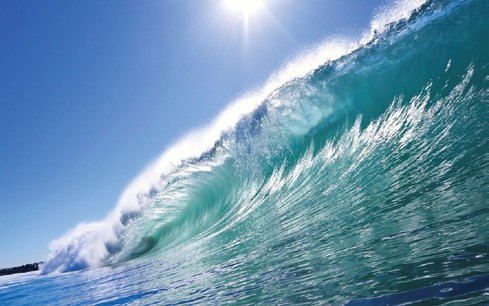How global warming changes our favorite places
By Hilary Kotoun, Social Impact Director, Sailors for the Sea
 “It is a curious situation that the sea, from which life first arose, should now be threatened by the activities of one form of that life. But the sea, though changed in a sinister way, will continue to exist: the threat is rather to life itself. – Rachel Carson
“It is a curious situation that the sea, from which life first arose, should now be threatened by the activities of one form of that life. But the sea, though changed in a sinister way, will continue to exist: the threat is rather to life itself. – Rachel Carson
The boating community exists in the boundary where land meets water, and today that boundary’s location is changing due to the impacts of global warming. Whether you hope to cruise San Francisco Bay where the backup of seawater into the sewage systems is a reoccurring problem, or race in Miami, FL where the ocean blankets the streets at high tide, global warming is currently impacting boaters all around the United States.
Sea Level Rise
By 2050, anticipated sea level rise will vary greatly along the 95,000 miles of U.S. coastline, but the consistent trend is that the tide is getting higher. In some locations – sea level rise is anticipated to be upwards of 2.3 feet in the next 36 years. The National Climate Assessment also looks at potential flooding events based on historic extreme weather events in a region such as spring high tides and hurricanes. When analyzing likeliness of storms such as Hurricane Sandy or Katrina – which were once predicted to occur “once every 100 years” – many coastal cities can expect that these will occur every five to twenty years.
Infrastructure Issues
Those who live along the coast and own docks, marinas, boats or waterfront property have already started to feel the rising tide. However sea level rise is not just a risk for private property. Much of the infrastructure in our country is along the coast. Our highways, which connect our ports and airports, bring goods from town to town and often hug the coastline. One of the strongest examples of this problem can be found in the Gulf Coast. Within this century, half of the major roadways in this region will be inundated by sea level rise.
We are in Hot Water
The ocean absorbs over 90% of the heat trapped by increasing levels of CO2 and other greenhouse gases in the atmosphere. This excess heat warms and expands the ocean, adding to sea level rise problems. Warming waters are also predicted to change ocean currents and circulation. With a 0.9°F rise in sea surface temperatures over the last century, ecosystem change can be seen in many areas of the ocean. In Hawaii and the Caribbean, coral bleaching is a persistent problem and only becoming worse. Coral bleaching occurs when water temperatures become too high, forcing reefs to expel the algae (zooxanthellae) that help nourish and give them their vibrant color. Coral reefs are essential spawning, nursery, breeding, and feeding grounds, and one of the most diverse ecosystems on the planet.
Oceans on Acid
Since the beginning of the industrial revolution, there has been an approximately 30% increase in surface ocean acidity. Along our coasts, regional differences in ocean pH occur as a result of variability in regional or local conditions. Additionally, coastal waters and estuaries can also exhibit acidification as the result of pollution and excess nutrient inputs, such as fertilizer runoff. Sailors and boaters can help mitigate this by using environmentally safe cleaning products and using compost, rather than toxic fertilizers at home or on marina lawns.
Coastal Pressures
Today, more than 50% of Americans, 164 million people, live in coastal counties, and every year 1.2 million more are added. This places heavy demands on the unique natural systems and resources that make our coastal areas so attractive and productive.
Coastal ecosystems provide many valuable benefits such as reducing flood impacts, buffering from storm surge and waves, providing nursery habitat for important marine species, water filtration, carbon storage, and opportunities for recreation and enjoyment. Coastal ecosystems in the United States have long faced environmental struggles. It’s time we start preserving and restoring these vital habitats.
How Global Warming Impacts Human Health
Climate change affects human health just as seriously as it does the environment and our property’s economic value. In the coming years, most impacts on human health will come from extreme weather events including:
- Wildfires and decreased air quality
- Increased days with temperatures over 100 degrees
- Traumatic extreme weather events
- Illnesses transmitted by food, water, and disease carrying insects
These events can lead to:
- Emergency room visits and medication for asthma, bronchitis and chest pain
- Increased cases of heat stroke and exhaustion, and particularly with elderly and young a greater risk of death from excessive heat
- Increased cases of anxiety and post-traumatic stress disorder from extreme weather events
- Increased exposure to Lyme disease, dengue fever and in rare cases diarrheal diseases
What Can be Done?
We need to act now to embrace big solutions to big problems that reduce the human carbon footprint.
- Be a part of the 10% – If 10% of the registered vehicles in the U.S. drove one mile less a day, it would eliminate 22 million tons of C02 emissions – the same amount that the ocean absorbs every day.
- Adaptation: After storms, don’t rebuild in the area that was destroyed, and work with your local government to prepare for sea level rise.
This Sailors for the Sea Ocean Watch Essay is reprinted with permission. For more information, visit sailorsforthesea.org.



